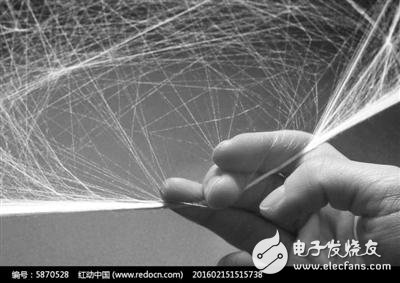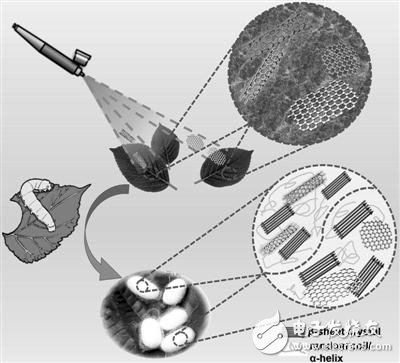After feeding graphene or single-walled carbon nanotubes to silkworms, spit out silk for use in wearable devices
After feeding the silkworms with graphene or single-walled carbon nanotubes, the toughness of the discharged silk is doubled, and the electrical conductivity of the carbonized silk is 10 times higher. This "super strong" silk can be used in durable protective fabrics, biodegradable medical implants and environmentally friendly wearable electronics. Every child who loves nature may have experienced sericulture. The verdant mulberry leaves, the white fat silkworms, and the peanut-sized silkworm cocoons on the broom become a happy piece of childhood memories. Recently, a report from the website of Scientific American magazine made the silkworm baby the "protagonist" of the topic.


The picture shows the schematic of the experimental process. Researchers sprayed an aqueous solution containing carbon nanotubes or graphene on mulberry leaves for feeding silkworms, and finally obtained silkworm cocoons with carbon nanotubes or graphene.
According to the report, researchers at Tsinghua University fed silkworms with graphene or single-walled carbon nanotubes, and the silk they spit out was stronger and stronger. This carbon nanomaterial-containing silk can be used in durable protective fabrics, biodegradable medical implants, and environmentally friendly wearable electronic devices.
The "super" silk spit out by the silkworms, which are "blessed" by high-tech, may only be comparable to the spider silk sprayed by Spider-Man. Then, curiosity brings a bunch of questions: mulberry leaves with graphene, silkworms are used to eating? How strong is the “super strong†silk? Is the wearable electronic device made with it available?
Mistakenly hit "super strong" silk discovery tour
Carbon nanotubes or graphene don't sound like serious food. How do you think of feeding silkworms something that can't be beaten with mulberry leaves? Zhang Yingying, an associate professor at the Department of Chemistry at Tsinghua University, said that this is not the "first initiative" of her team. In order to make silk "natural" different, Korean scientists and Chinese scientists have carried out similar experiments.
Developing materials for wearable electronic devices, silk as a skin-friendly natural material, is the first choice for wearable electronic devices. As a material for wearable electronic devices, it is required not only for strength and toughness, but also for electrical conductivity. The silk itself is non-conductive and needs to be converted into highly conductive carbonized silk by simple high temperature heat treatment.
However, in the process of high-temperature carbonization, the silk becomes hard and brittle, and the flexibility is reduced. Can you feed the silkworm with conductive material and let it spit out the conductive function? Try to spray an aqueous solution containing carbon nanotubes or graphene into the mulberry leaves of the silkworm larvae, and then collect the silk after the larvae are silky and crusted.
Taking into account the taste of the silkworm and the adaptability of the stomach, two kinds of formulations were prepared, which were aqueous solutions with a concentration of 1.0% and 0.2%, respectively, from the third instar of the silkworm to the fifth instar. Like the age of human beings, the growth of silkworms also has silkworm age. The first time the skin is called the first age, and so on. After the fifth age, the silkworm enters the crusting stage.
An aqueous solution with a concentration of 1.0% may be too heavy, and some of the silkworms fed the solution will be unfortunate. But the team members were pleased that the silkworms fed a 0.2% solution grew white and fat and could not see any discomfort. After 20 days of careful feeding, I finally got a rounded voice.
Soon, the time for the "winning" was over. The frustrating thing is that the collected silk does not have its own conductive function. However, the surprise is behind. The researchers found that its toughness against external damage doubled and the stress was at least 50% higher.
Since it is not conductive, it is inevitable to carbonize. The research team heated the wire to 1050 degrees Celsius in an inert gas to study the electrical conductivity and microstructure of the carbonized silk. The carbonized silk is about 10 times more conductive than ordinary carbonized silk, and Raman spectroscopy and electron microscopy imaging show that the carbonized silk containing carbon nanomaterials has a higher degree of graphitization.
“In general, the natural silk we get is not conductive, but its strength and toughness are significantly improved. And the conductivity after carbonization is better than that after ordinary carbonization,†explains Zhang Yingying.
Looking forward to multidisciplinary cross-examination of the internal mechanismWhy do silkworms that eat carbon nanotubes and graphene emit different silk? How does the formula solution that is eaten in the silkworm body absorb and transform? What is the correspondence between the concentration of the solution and the mechanical properties of the wire?
In this regard, their research indicates that lower concentrations of carbon nanotubes or graphene can prevent the conversion of the random coil structure in the silk fibroin molecule to the folded-fold structure, thus making the obtained silk more High ductility and toughness. However, if the content of the carbon nanomaterial is too high, defects such as agglomeration may be caused, and the mechanical properties of the silk are lowered, and the mechanical properties of the silk obtained by using the 1.0% concentration are lower than those of the ordinary silk.
The transfer of carbon nanotubes and graphene in silkworm is a very complicated physiological process. The specific mechanism and influencing factors are still unclear. I hope that a team with a biological background can participate and help uncover the mystery and do it in the future. Natural silk with excellent mechanical and electrical properties.
In fact, it is limited by experimental conditions. On the one hand, sericulture is a relatively cumbersome and time-consuming process. In addition, the temperature in the north is relatively low, and most of the year is not suitable for the survival of silkworms.
In the first round of experiments, we only carried out feeding experiments with two concentration solutions. In the future, we need to do more experiments to find better concentration values ​​to obtain silk with better mechanical properties.
In addition to the solution concentration, the start of feeding a "special recipe" is another issue worth exploring. In the 20-day period from 3rd to 5th, the silkworms have the best feeding effect at any stage, and further experiments are needed to verify. “We learned that the silk gland development of silkworms started from the age of 5, so it is possible that the feeding from the 3rd to 4th age has no effect on the final silk produced. If so, we can postpone the use. The time for special recipes." Zhang Yingying added.
It is reported that silk companies that are interested in this technology have expressed their willingness to provide workshops, batches of silkworms and technicians to cooperate in more in-depth and large-scale experiments.
The closest wearable device to marketizationAlthough the study of feeding silkworms with specific concentrations of graphene or carbon nanotubes to obtain "super strong" silk is still in the laboratory stage, if it is successful in obtaining conductive natural silk in the future, it will have a series of important application values. She said that other scientists at home and abroad have also carried out similar experiments. For example, Professor Shen Qing from Shanghai Donghua University used to feed silkworms with multi-walled carbon nanotubes with a diameter of about 30 nanometers in 2014 to produce new types of silk fibers. Korean scientists once fed silkworms with quantum dots and obtained color. Cocoon and so on.
In addition, in addition to the above work, the researchers also developed high-temperature carbonization technology using common silk fabrics on the market as raw materials, and can be made into flexible wearable device sensors with high sensitivity and wide strain detection range. This sensor can be used for wearable detection of human body full-scale motion by directly attaching to human skin or loading on clothing and accessories.
“This sensor can detect small-scale motion such as running, jumping, and other small-scale motions such as pulse, micro-expression, breathing, and vocal vocalization. It can also be integrated with signal processing and command generation systems to capture human motion. And reconstruction. This technology has great application potential in human physiological signal detection, motion tracking and limb rehabilitation, virtual reality, human-computer interaction, etc." Zhang Yingying further exemplified.
Will silk raw materials increase the cost of wearable electronic devices? China is the country with the largest silk production. The cost of silk fabric is only 30 to 50 yuan per square meter, and each square meter of silk cloth can be made into a large number of flexible sensors. In the future, if the silkworm is fed to obtain the experimental results of conductive silk, even if it is The cost of feeding graphene or carbon nanotubes to silkworms is also acceptable.
Wearable electronic devices made of silk sound cool. In the near future, you may be able to try it for yourself.
Power Source,arcade power supply switch,power supply for game,vending power supply
Guangzhou Ruihong Electronic Technology CO.,Ltd , http://www.callegame.com